599 scholarly books by Russell Sage Foundation and 18
start with M
599 scholarly books by Russell Sage Foundation and 18
599 scholarly books by Russell Sage Foundation
18 start with M start with M
18 start with M start with M
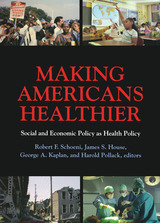
Making Americans Healthier
Social and Economic Policy as Health Policy
Robert F. Schoeni
Russell Sage Foundation, 2008
The United States spends billions of dollars annually on social and economic policies aimed at improving the lives of its citizens, but the health consequences associated with these policies are rarely considered. In Making Americans Healthier, a group of multidisciplinary experts shows how social and economic policies seemingly unrelated to medical well-being have dramatic consequences for the health of the American people. Most previous research concerning problems with health and healthcare in the United States has focused narrowly on issues of medical care and insurance coverage, but Making Americans Healthier demonstrates the important health consequences that policymakers overlook in traditional cost-benefit evaluations of social policy. The contributors examine six critical policy areas: civil rights, education, income support, employment, welfare, and neighborhood and housing. Among the important findings in this book, David Cutler and Adriana Lleras-Muney document the robust relationship between educational attainment and health, and estimate that the health benefits of education may exceed even the well-documented financial returns of education. Pamela Herd, James House, and Robert Schoeni discover notable health benefits associated with the Supplemental Security Income Program, which provides financial support for elderly and disabled Americans. George Kaplan, Nalini Ranjit, and Sarah Burgard document a large and unanticipated improvement in the health of African-American women following the enactment of civil rights legislation in the 1960s. Making Americans Healthier presents ground-breaking evidence that the health impact of many social policies is substantial. The important findings in this book pave the way for promising new avenues for intervention and convincingly demonstrate that ultimately social and economic policy is health policy. A Volume in the National Poverty Center Series on Poverty and Public Policy
[more]
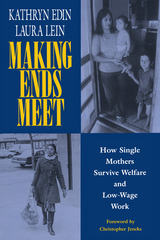
Making Ends Meet
How Single Mothers Survive Welfare and Low-Wage Work
Kathryn Edin
Russell Sage Foundation, 1997
Welfare mothers are popularly viewed as passively dependent on their checks and averse to work. Reformers across the political spectrum advocate moving these women off the welfare rolls and into the labor force as the solution to their problems. Making Ends Meet offers dramatic evidence toward a different conclusion: In the present labor market, unskilled single mothers who hold jobs are frequently worse off than those on welfare, and neither welfare nor low-wage employment alone will support a family at subsistence levels. Kathryn Edin and Laura Lein interviewed nearly four hundred welfare and low-income single mothers from cities in Massachusetts, Texas, Illinois, and South Carolina over a six year period. They learned the reality of these mothers' struggles to provide for their families: where their money comes from, what they spend it on, how they cope with their children's needs, and what hardships they suffer. Edin and Lein's careful budgetary analyses reveal that even a full range of welfare benefits—AFDC payments, food stamps, Medicaid, and housing subsidies—typically meet only three-fifths of a family's needs, and that funds for adequate food, clothing and other necessities are often lacking. Leaving welfare for work offers little hope for improvement, and in many cases threatens even greater hardship. Jobs for unskilled and semi-skilled women provide meager salaries, irregular or uncertain hours, frequent layoffs, and no promise of advancement. Mothers who work not only assume extra child care, medical, and transportation expenses but are also deprived of many of the housing and educational subsidies available to those on welfare. Regardless of whether they are on welfare or employed, virtually all these single mothers need to supplement their income with menial, off-the-books work and intermittent contributions from family, live-in boyfriends, their children's fathers, and local charities. In doing so, they pay a heavy price. Welfare mothers must work covertly to avoid losing benefits, while working mothers are forced to sacrifice even more time with their children. Making Ends Meet demonstrates compellingly why the choice between welfare and work is more complex and risky than is commonly recognized by politicians, the media, or the public. Almost all the welfare-reliant women interviewed by Edin and Lein made repeated efforts to leave welfare for work, only to be forced to return when they lost their jobs, a child became ill, or they could not cover their bills with their wages. Mothers who managed more stable employment usually benefited from a variety of mitigating circumstances such as having a relative willing to watch their children for free, regular child support payments, or very low housing, medical, or commuting costs. With first hand accounts and detailed financial data, Making Ends Meet tells the real story of the challenges, hardships, and survival strategies of America's poorest families. If this country's efforts to improve the self-sufficiency of female-headed families is to succeed, reformers will need to move beyond the myths of welfare dependency and deal with the hard realities of an unrewarding American labor market, the lack of affordable health insurance and child care for single mothers who work, and the true cost of subsistence living. Making Ends Meet is a realistic look at a world that so many would change and so few understand.
[more]
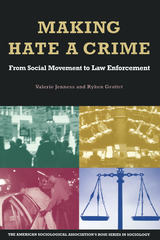
Making Hate A Crime
From Social Movement to Law Enforcement
Valerie Jenness
Russell Sage Foundation, 2001
Violence motivated by racism, anti-Semitism, misogyny, and homophobia weaves a tragic pattern throughout American history. Fueled by recent high-profile cases, hate crimes have achieved an unprecedented visibility. Only in the past twenty years, however, has this kind of violence—itself as old as humankind—been specifically categorized and labeled as hate crime. Making Hate a Crime is the first book to trace the emergence and development of hate crime as a concept, illustrating how it has become institutionalized as a social fact and analyzing its policy implications. In Making Hate a Crime Valerie Jenness and Ryken Grattet show how the concept of hate crime emerged and evolved over time, as it traversed the arenas of American politics, legislatures, courts, and law enforcement. In the process, violence against people of color, immigrants, Jews, gays and lesbians, women, and persons with disabilities has come to be understood as hate crime, while violence against other vulnerable victims-octogenarians, union members, the elderly, and police officers, for example-has not. The authors reveal the crucial role social movements played in the early formulation of hate crime policy, as well as the way state and federal politicians defined the content of hate crime statutes, how judges determined the constitutional validity of those statutes, and how law enforcement has begun to distinguish between hate crime and other crime. Hate crime took on different meanings as it moved from social movement concept to law enforcement practice. As a result, it not only acquired a deeper jurisprudential foundation but its scope of application has been restricted in some ways and broadened in others. Making Hate a Crime reveals how our current understanding of hate crime is a mix of political and legal interpretations at work in the American policymaking process. Jenness and Grattet provide an insightful examination of the birth of a new category in criminal justice: hate crime. Their findings have implications for emerging social problems such as school violence, television-induced violence, elder-abuse, as well as older ones like drunk driving, stalking, and sexual harassment. Making Hate a Crime presents a fresh perspective on how social problems and the policies devised in response develop over time. A Volume in the American Sociological Association's Rose Series in Sociology
[more]
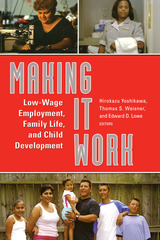
Making It Work
Low-Wage Employment, Family Life, and Child Development
Hirokazu Yoshikawa
Russell Sage Foundation, 2006
Low-skilled women in the 1990s took widely different paths in trying to support their children. Some held good jobs with growth potential, some cycled in and out of low-paying jobs, some worked part time, and others stayed out of the labor force entirely. Scholars have closely analyzed the economic consequences of these varied trajectories, but little research has focused on the consequences of a mother's career path on her children's development. Making It Work, edited by Hirokazu Yoshikawa, Thomas Weisner, and Edward Lowe, looks past the economic statistics to illustrate how different employment trajectories affect the social and emotional lives of poor women and their children. Making It Work examines Milwaukee's New Hope program, an experiment testing the effectiveness of an anti-poverty initiative that provided health and child care subsidies, wage supplements, and other services to full-time low-wage workers. Employing parent surveys, teacher reports, child assessment measures, ethnographic studies, and state administrative records, Making It Work provides a detailed picture of how a mother's work trajectory affects her, her family, and her children's school performance, social behavior, and expectations for the future. Rashmita Mistry and Edward D. Lowe find that increases in a mother's income were linked to higher school performance in her children. Without large financial worries, mothers gained extra confidence in their ability to parent, which translated into better test scores and higher teacher appraisals for their children. JoAnn Hsueh finds that the children of women with erratic work schedules and non-standard hours—conditions endemic to the low-skilled labor market—exhibited higher levels of anxiety and depression. Conversely, Noemi Enchautegui-de-Jesus, Hirokazu Yoshikawa, and Vonnie McLoyd discover that better job quality predicted lower levels of acting-out and withdrawal among children. Perhaps most surprisingly, Anna Gassman-Pines, Hirokazu Yoshikawa, and Sandra Nay note that as wages for these workers rose, so did their marriage rates, suggesting that those worried about family values should also be concerned with alleviating poverty in America. It is too simplistic to say that parental work is either "good" or "bad" for children. Making It Work gives a nuanced view of how job quality, flexibility, and wages are of the utmost importance for the well-being of low-income parents and children.
[more]
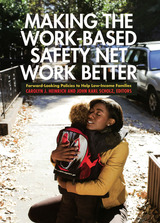
Making the Work-Based Safety Net Work Better
Forward-Looking Policies to Help Low-Income Families
Carolyn J. Heinrich
Russell Sage Foundation, 2009
Work first. That is the core idea behind the 1996 welfare reform legislation. It sounds appealing, but according to Making the Work-Based Safety Net Work Better, it collides with an exceptionally difficult reality. The degree to which work provides a way out of poverty depends greatly on the ability of low-skilled people to maintain stable employment and make progress toward an income that provides an adequate standard of living. This forward-looking volume examines eight areas of the safety net where families are falling through and describes how current policies and institutions could evolve to enhance the self-sufficiency of low-income families. David Neumark analyzes a range of labor market policies and finds overwhelming evidence that the minimum wage is ineffective in promoting self-sufficiency. Neumark suggests the Earned Income Tax Credit is a much more promising policy to boost employment among single mothers and family incomes. Greg Duncan, Lisa Gennetian, and Pamela Morris find no evidence that encouraging parents to work leads to better parenting, improved psychological health, or more positive role models for children. Instead, the connection between parental work and child achievement is linked to parents' improved access to quality child care. Rebecca Blank and Brian Kovak document an alarming increase in the number of single mothers who receive neither wages nor public assistance and who are significantly more likely to suffer from medical problems of their own or of a child. Time caps and work hour requirements embedded in benefits policies leave some mothers unable to work and ineligible for cash benefits. Marcia Meyers and Janet Gornick identify another gap: low-income families tend to lose financial support and health coverage long before they earn enough to access employer-based benefits and tax provisions. They propose building "institutional bridges" that minimize discontinuities associated with changes in employment, earnings, or family structure. Steven Raphael addresses a particularly troubling weakness of the work-based safety net—its inadequate provision for the large number of individuals who are or were incarcerated in the United States. He offers tractable suggestions for policy changes that could ease their transition back into non-institutionalized society and the labor market. Making the Work-Based Safety Net Work Better shows that the "work first" approach alone isn't working and suggests specific ways the social welfare system might be modified to produce greater gains for vulnerable families.
[more]
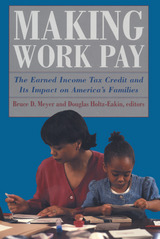
Making Work Pay
Bruce D. Meyer
Russell Sage Foundation, 2001
Since its inception under President Ford in 1975, the Earned Income Tax Credit (EITC) has become the largest antipoverty program for the non-elderly in the United States. In 1998, more than nineteen million families received EITC payments, and the program lifted over four million Americans above the poverty line. Despite the rapid growth of the EITC throughout the 1990s, little has been written about how the program works or how it affects low-income families. Making Work Pay provides the first full-scale examination of the EITC, exploring its effects on income distribution, poverty, work, and marriage. Making Work Pay opens with a history of the EITC—its emergence in the 1970s as a pro-work, low-cost antipoverty program and its expansion through the 1980s and 1990s. The central chapters in the volume look at the substantial impact of the EITC on work incentives in recent years and show that the program, in combination with welfare reform and a strong economy, has led to an unprecedented increase in the employment of single mothers. In one study, researchers conclude that the EITC—with its stipulation that one family member be a wage earner—was the most important change in work incentives for single mothers between 1984 and 1996, a period when the employment rate of single mothers rose sharply. Several chapters outline proposals for reforming the program, addressing the concerns by policymakers about the work disincentives that rise as benefits fall with increasing income. Finally, Making Work Pay examines how EITC recipients view the credit and what they do with it once they get it. The contributors find that not only does EITC's lump-sum payment increase consumption but it also allows recipients to make changes in economic status. Many families use the end-of-the-year payment as a form of forced savings, enabling them to save for home improvement, a new car, or other purchases to improve their lives, and providing the extra economic cushion needed to move beyond mere day-to-day survival. Comprehensive in scope, Making Work Pay is an indispensable resource for policymakers, administrators, and researchers seeking to understand the ramifications of the country's largest programs for aiding the working poor.
[more]
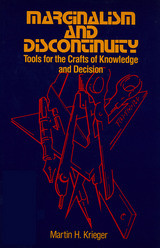
Marginalism and Discontinuity
Tools for the Crafts of Knowledge and Decision
Martin H. Krieger
Russell Sage Foundation, 1989
Marginalism and Discontinuity is an account of the culture of models employed in the natural and social sciences, showing how such models are instruments for getting hold of the world, tools for the crafts of knowing and deciding. Like other tools, these models are interpretable cultural objects, objects that embody traditional themes of smoothness and discontinuity, exchange and incommensurability, parts and wholes. Martin Krieger interprets the calculus and neoclassical economics, for example, as tools for adding up a smoothed world, a world of marginal changes identified by those tools. In contrast, other models suggest that economies might be sticky and ratchety or perverted and fetishistic. There are as well models that posit discontinuity or discreteness. In every city, for example, some location has been marked as distinctive and optimal; around this created differentiation, a city center and a city periphery eventually develop. Sometimes more than one model is applicable—the possibility of doom may be seen both as the consequence of a series of mundane events and as a transcendent moment. We might model big decisions or entrepreneurial endeavors as sums of several marginal decisions, or as sudden, marked transitions, changes of state like freezing or religious conversion. Once we take models and theory as tools, we find that analogy is destiny. Our experiences make sense because of the analogies or tools used to interpret them, and our intellectual disciplines are justified and made meaningful through the employment of characteristic toolkits—a physicist's toolkit, for example, is equipped with a certain set of mathematical and rhetorical models. Marginalism and Discontinuity offers a provocative and wide-ranging consideration of the technologies by which we attempt to apprehend the world. It will appeal to social and natural scientists, mathematicians and philosophers, and thoughtful educators, policymakers, and planners.
[more]
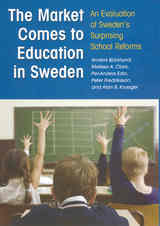
The Market Comes to Education in Sweden
An Evaluation of Sweden's Surprising School Reforms
Anders Bjorklund
Russell Sage Foundation, 2005
A large central government providing numerous public services has long been a hallmark of Swedish society, which is also well-known for its pursuit of equality. Yet in the 1990s, Sweden moved away from this tradition in education, introducing market-oriented reforms that decentralized authority over public schools and encouraged competition between private and public schools. Many wondered if this approach would improve educational quality, or if it might expand inequality that Sweden has fought so hard to hold down. In The Market Comes to Education in Sweden, economists Anders Björklund, Melissa Clark, Per-Anders Edin, Peter Fredriksson, and Alan Krueger measure the impact of Sweden's bold experiment in governing and help answer the questions that societies across the globe have been debating as they try to improve their children's education. The Market Comes to Education in Sweden injects some much-needed objectivity into the heavily politicized debate about the effectiveness of educational reform. While advocates for reform herald the effectiveness of competition in improving outcomes, others suggest that the reforms will grossly increase educational inequality for young people. The authors find that increased competition did help improve students' math and language skills, but only slightly, and with no effect on the performance of foreign-born students and those with low-educated parents. They also find some signs of increasing school segregation and wider inequality in student performance, but nothing near the doomsday scenarios many feared. In fact, the authors note that the relationship between family background and school performance has hardly budged since before the reforms were enacted. The authors conclude by providing valuable recommendations for school reform, such as strengthening school evaluation criteria, which are essential for parents, students, and governments to make competent decisions regarding education. Whether or not the market-oriented reforms to Sweden's educational system succeed will have far reaching implications for other countries considering the same course of action. The Market Comes to Education in Sweden offers firm empirical answers to the questions raised by school reform and brings crucial facts to the debate over the future of schooling in countries across the world.
[more]
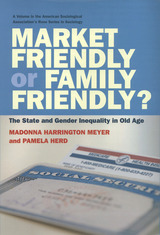
Market Friendly or Family Friendly?
The State and Gender Inequality in Old Age
Madonna Harrington Meyer
Russell Sage Foundation, 2007
Poverty among the elderly is sharply gendered—women over sixty-five are twice as likely as men to live below the poverty line. Older women receive smaller Social Security payments and are less likely to have private pensions. They are twice as likely as men to need a caregiver and twice as likely as men to be a caregiver. Recent efforts of some in Washington to reduce and privatize social welfare programs threaten to exacerbate existing gender disparities among older Americans. They also threaten to exacerbate inequality among women by race, class, and marital status. Madonna Harrington Meyer and Pamela Herd explain these disparities and assess how proposed policy reforms would affect inequality among the aged. Market Friendly or Family Friendly? documents the cumulative disadvantages that make it so difficult for women to achieve economic and health security when they retire. Wage discrimination and occupational segregation reduce women's lifetime earnings, depressing their savings and Social Security benefits. While more women are employed today than a generation ago, they continue to shoulder a greater share of the care burden for children, the disabled, and the elderly. Moreover, as marriage rates have declined, more working mothers are raising children single-handedly. Women face higher rates of health problems due to their lower earnings and the high demands associated with unpaid care work. There are also financial consequences to these family and work patterns. Harrington Meyer and Herd contrast the impact of market friendly programs that maximize individual choice, risk, and responsibility with family friendly programs aimed at redistributing risks and resources. They evaluate popular policies on the current agenda, considering the implications for inequality. But they also evaluate less discussed policy proposals. In particular, minimum benefits for Social Security, as well as credits for raising children, would improve economic security for all, regardless of marital status. National health insurance would also reduce inequality, as would reforms to Medicare, particularly increased coverage of long term care. Just as important are policies such as universal preschool and paid family leave aimed at reducing the disadvantages women face during their working years. The gender gaps that women experience during their work and family lives culminate in income and health disparities between men and women during retirement, but the problem has received scant attention. Market Friendly or Family Friendly? is a comprehensive introduction to this issue, and a significant contribution to the debate over the future of America's entitlement programs. A Volume in the American Sociological Association's Rose Series in Sociology
[more]

Marriage Vows and Racial Choices
Jessica Vasquez-Tokos
Russell Sage Foundation, 2017
Choosing whom to marry involves more than emotion, as racial politics, cultural mores, and local demographics all shape romantic choices. In Marriage Vows and Racial Choices, sociologist Jessica Vasquez-Tokos explores the decisions of Latinos who marry either within or outside of their racial and ethnic groups. Drawing from in-depth interviews with nearly 50 couples, she examines their marital choices and how these unions influence their identities as Americans.
Vasquez-Tokos finds that their experiences in childhood, adolescence, and young adulthood shape their perceptions of race, which in turn influence their romantic expectations. Most Latinos marry other Latinos, but those who intermarry tend to marry whites. She finds that some Latina women who had domineering fathers assumed that most Latino men shared this trait and gravitated toward white men who differed from their fathers. Other Latina respondents who married white men fused ideas of race and class and perceived whites as higher status and considered themselves to be “marrying up.” Latinos who married non-Latino minorities—African Americans, Asian Americans, and Native Americans—often sought out non-white partners because they shared similar experiences of racial marginalization. Latinos who married Latinos of a different national origin expressed a desire for shared cultural commonalities with their partners, but—like those who married whites—often associated their own national-origin groups with oppressive gender roles.
Vasquez-Tokos also investigates how racial and cultural identities are maintained or altered for the respondents’ children. Within Latino-white marriages, biculturalism—in contrast with Latinos adopting a white “American” identity—is likely to emerge. For instance, white women who married Latino men often embraced aspects of Latino culture and passed it along to their children. Yet, for these children, upholding Latino cultural ties depended on their proximity to other Latinos, particularly extended family members. Both location and family relationships shape how parents and children from interracial families understand themselves culturally.
As interracial marriages become more common, Marriage Vows and Racial Choices shows how race, gender, and class influence our marital choices and personal lives.
Vasquez-Tokos finds that their experiences in childhood, adolescence, and young adulthood shape their perceptions of race, which in turn influence their romantic expectations. Most Latinos marry other Latinos, but those who intermarry tend to marry whites. She finds that some Latina women who had domineering fathers assumed that most Latino men shared this trait and gravitated toward white men who differed from their fathers. Other Latina respondents who married white men fused ideas of race and class and perceived whites as higher status and considered themselves to be “marrying up.” Latinos who married non-Latino minorities—African Americans, Asian Americans, and Native Americans—often sought out non-white partners because they shared similar experiences of racial marginalization. Latinos who married Latinos of a different national origin expressed a desire for shared cultural commonalities with their partners, but—like those who married whites—often associated their own national-origin groups with oppressive gender roles.
Vasquez-Tokos also investigates how racial and cultural identities are maintained or altered for the respondents’ children. Within Latino-white marriages, biculturalism—in contrast with Latinos adopting a white “American” identity—is likely to emerge. For instance, white women who married Latino men often embraced aspects of Latino culture and passed it along to their children. Yet, for these children, upholding Latino cultural ties depended on their proximity to other Latinos, particularly extended family members. Both location and family relationships shape how parents and children from interracial families understand themselves culturally.
As interracial marriages become more common, Marriage Vows and Racial Choices shows how race, gender, and class influence our marital choices and personal lives.
[more]
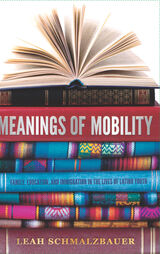
Meanings of Mobility
Family, Education, and Immigration in the Lives of Latino Youth
Leah Schmalzbauer
Russell Sage Foundation, 2023
Over the past twenty years, elite colleges and universities enacted policies that reshaped the racial and class composition of their campuses, and over the past decade, Latinos’ college attendance notably increased. While discussions on educational mobility often focus on its perceived benefits – that it will ultimately lead to social and economic mobility – less attention is paid to the process of “making it” and the challenges low-income youth experience when navigating these elite spaces. In Meanings of Mobility, sociologist Leah C. Schmalzbauer explores the experiences of low-income Latino youth attending highly selective, elite colleges.
To better understand these experiences, Schmalzbauer draws on interviews with 60 low-income Latino youth who graduated or were set to graduate from Amherst College, one of the most selective private colleges in the United States. The vast majority of these students were the first in their immigrant families to go to college in the U.S. She finds that while most of the students believed attending Amherst provided them with previously unimaginable opportunities, adjusting to life on campus came with significant challenges. Many of the students Schmalzbauer spoke with had difficulties adapting to the cultural norms at Amherst as well as with relating to their non-Latino, non-low-income peers. The challenges these students faced were not limited to life on campus. As they attempted to adapt to Amherst, many felt distanced from the family and friends they left behind who could not understand the new challenges they faced.
The students credit their elite education for access to extraordinary educational and employment opportunities. However, their experiences while in college and afterward reveal that the relationship between educational and social mobility is much more complicated and less secure than popular conversations about the “American Dream” suggest. Many students found that their educational attainment was not enough to erase the core challenges of growing up in a marginalized immigrant family: many were still poor, faced racism, and those who were undocumented or had undocumented family members still feared deportation.
Schmalzbeauer suggests ways elite colleges can better support low-income Latino students and lower the emotional price of educational mobility, including the creation of immigration offices on campus to provide programming and support for undocumented students and their families. She recommends educating staff to better understand the centrality of family for these students and the challenges they face, as well as educating more privileged students about inequality and the life experiences of their marginalized peers.
Meanings of Mobility provides compelling insights into the difficulties faced by low-income Latinos pursuing educational and social mobility in America’s elite institutions.
To better understand these experiences, Schmalzbauer draws on interviews with 60 low-income Latino youth who graduated or were set to graduate from Amherst College, one of the most selective private colleges in the United States. The vast majority of these students were the first in their immigrant families to go to college in the U.S. She finds that while most of the students believed attending Amherst provided them with previously unimaginable opportunities, adjusting to life on campus came with significant challenges. Many of the students Schmalzbauer spoke with had difficulties adapting to the cultural norms at Amherst as well as with relating to their non-Latino, non-low-income peers. The challenges these students faced were not limited to life on campus. As they attempted to adapt to Amherst, many felt distanced from the family and friends they left behind who could not understand the new challenges they faced.
The students credit their elite education for access to extraordinary educational and employment opportunities. However, their experiences while in college and afterward reveal that the relationship between educational and social mobility is much more complicated and less secure than popular conversations about the “American Dream” suggest. Many students found that their educational attainment was not enough to erase the core challenges of growing up in a marginalized immigrant family: many were still poor, faced racism, and those who were undocumented or had undocumented family members still feared deportation.
Schmalzbeauer suggests ways elite colleges can better support low-income Latino students and lower the emotional price of educational mobility, including the creation of immigration offices on campus to provide programming and support for undocumented students and their families. She recommends educating staff to better understand the centrality of family for these students and the challenges they face, as well as educating more privileged students about inequality and the life experiences of their marginalized peers.
Meanings of Mobility provides compelling insights into the difficulties faced by low-income Latinos pursuing educational and social mobility in America’s elite institutions.
[more]
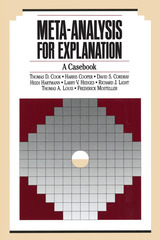
Meta-Analysis for Explanation
A Casebook
Thomas D. Cook
Russell Sage Foundation, 1992
Social science research often yields conflicting results: Does juvenile delinquent rehabilitation work? Is teenage pregnancy prevention effective? In an effort to improve the value of research for shaping social policy, social scientists are increasingly employing a powerful technique called meta-analysis. By systematically pulling together findings of a particular research problem, meta-analysis allows researchers to synthesize the results of multiple studies and detect statistically significant patterns among them. Meta-Analysis for Explanation brings exemplary illustrations of research synthesis together with expert discussion of the use of meta-analytic techniques. The emphasis throughout is on the explanatory applications of meta-analysis, a quality that makes this casebook distinct from other treatments of this methodology. The book features four detailed case studies by Betsy Jane Becker, Elizabeth C. Devine, Mark W. Lipsey, and William R. Shadish, Jr. These are offered as meta-analyses that seek both to answer the descriptive questions to which research synthesis is traditionally directed in the health and social sciences, and also to explore how a more systematic method of explanation might enhance the policy yield of research reviews. To accompany these cases, a group of the field's leading scholars has written several more general chapters that discuss the history of research synthesis, the use of meta-analysis and its value for scientific explanation, and the practical issues and challenges facing researchers who want to try this new technique. As a practical resource, Meta-Analysis for Explanation guides social scientists to greater levels of sophistication in their efforts to synthesize the results of social research. "This is an important book...[it is] another step in the continuing exploration of the wider implications and powers of meta-analytic methods." —Contemporary Psychology
[more]
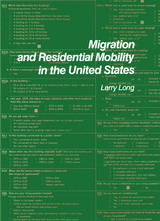
Migration and Residential Mobility in the United States
Larry Long
Russell Sage Foundation, 1988
Americans have a reputation for moving often and far, for being committed to careers or lifestyles, not place. Now, with curtailed fertility, residential mobility plays an even more important role in the composition of local populations—and by extension, helps shape local and national economic trends, social service requirements, and political constituencies. In Migration and Residential Mobility in the United States, Larry Long integrates diverse census and survey data and draws on many academic disciplines to offer a uniquely comprehensive view of internal migration patterns since the 1930s. Long describes an American population that lives up to its reputation for high mobility, but he also reports a surprising recent decline in interstate migration and an unexpected fluctuation in the migration balance toward nonmetropolitan areas. He provides unprecedented insight into reasons for moving and explores return and repeat migration, regional balance, changing migration flows of blacks and whites, and the policy implications of movement by low-income populations. How often, how far, and why people move are important considerations in characterizing the lifestyles of individuals and the nature of social institutions. This volume illuminates the extent and direction, as well as the causes and consequences, of population turnover in the United States. A Volume in the Russell Sage Foundation Census Series
[more]
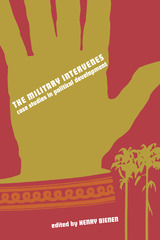
The Military Intervenes
Case Studies in Political Development
Henry Bienen
Russell Sage Foundation, 1968
Explores the mechanisms of military intervention and its consequences. The contributors examine a succession of coups, attempted coups, and established military regimes, with a view to evaluate the role of the military as a ruling group and an organization fostering political development. These studies cast strong doubt on the abilities of the military as a modernizing and stabilizing agent, raising important questions about our policies on military assistance and arms sales. Bienen makes an especially strong plea for a reassessment of our military and economic-political policies in order to determine whether both are working toward the same goals.
[more]
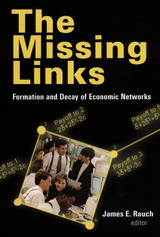
The Missing Links
Formation and Decay of Economic Networks
James E. Rauch
Russell Sage Foundation, 2007
Half of all workers are hired through personal referrals, and networks of social connections channel the flows of capital, technology, and international trade. Sociologists and economists alike recognize that economic exchange is shaped by social networks, which propagate information and facilitate trust, but each discipline brings a distinct theoretical perspective to the study of networks. Sociologists have focused on how networks shape individual behavior, economists on how individual choices shape networks. The Missing Links is a bold effort by an interdisciplinary group of scholars to synthesize sociological and economic theories of how economic networks emerge and evolve. Interweaving sophisticated theoretical models and concrete case studies, The Missing Links is both an introduction to the study of economic networks and a catalyst for further research. Economists Rachel Kranton and Deborah Minehart illustrate their field's approach to modeling network formation, showing how manufacturers form networks of suppliers in ways that maximize profits. Exemplifying the sociological approach, Ronald Burt analyzes patterns of cooperation and peer evaluations among colleagues at a financial organization. He finds that dense connections of shared acquaintances lead to more stable reputations. In the latter half of the book, contributors combine the insights of sociology and economics to explore a series of case studies. Ray Reagans, Ezra Zuckerman, and Bill McEvily investigate an R & D firm in which employees participate in overlapping collaborative teams, allowing the authors to disentangle the effects of network structure and individual human capital on team performance. Kaivan Munshi and Mark Rosenzweig examine how economic development and rising inequality in India are reshaping caste-based networks of mutual insurance and job referrals. Their study shows that people's economic decisions today are shaped both by the legacy of the caste hierarchies and by the particular incentives and constraints that each individual faces in an evolving labor market. Economic globalization is forging new connections between people in distant corners of the world, while unsettling long-standing social relations. Anyone interested in understanding the opportunities and challenges of this era of rapid change will find a highly informative guide in The Missing Links.
[more]
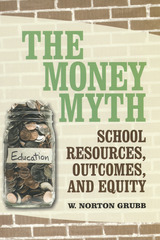
The Money Myth
School Resources, Outcomes, and Equity
W. Norton Grubb
Russell Sage Foundation, 2009
Can money buy high-quality education? Studies find only a weak relationship between public school funding and educational outcomes. In The Money Myth, W. Norton Grubb proposes a powerful paradigm shift in the way we think about why some schools thrive and others fail. The greatest inequalities in America's schools lie in factors other than fiscal support. Fundamental differences in resources other than money—for example, in leadership, instruction, and tracking policies—explain the deepening divide in the success of our nation's schoolchildren. The Money Myth establishes several principles for a bold new approach to education reform. Drawing on a national longitudinal dataset collected over twelve years, Grubb makes a crucial distinction between "simple" resources and those "compound," "complex," and "abstract" resources that cannot be readily bought. Money can buy simple resources—such as higher teacher salaries and smaller class sizes—but these resources are actually some of the weakest predictors of educational outcomes. On the other hand, complex resources pertaining to school practices are astonishingly strong predictors of success. Grubb finds that tracking policies have the most profound and consistent impact on student outcomes over time. Schools often relegate low-performing students—particularly minorities—to vocational, remedial, and special education tracks. So even in well-funded schools, resources may never reach the students who need them most. Grubb also finds that innovation in the classroom has a critical impact on student success. Here, too, America's schools are stratified. Teachers in underperforming schools tend to devote significant amounts of time to administration and discipline, while instructors in highly ranked schools dedicate the bulk of their time to "engaged learning," using varied pedagogical approaches. Effective schools distribute leadership among many instructors and administrators, and they foster a sense of both trust and accountability. These schools have a clear mission and coherent agenda for reaching goals. Underperforming schools, by contrast, implement a variety of fragmented reforms and practices without developing a unified plan. This phenomenon is perhaps most powerfully visible in the negative repercussions of No Child Left Behind. In a frantic attempt to meet federal standards and raise test scores quickly, more and more schools are turning to scripted "off the shelf" curricula. These practices discourage student engagement, suppress teacher creativity, and hold little promise of improving learning beyond the most basic skills. Grubb shows that infusions of money alone won't eradicate inequality in America's schools. We need to address the vast differences in the way school communities operate. By looking beyond school finance, The Money Myth gets to the core reasons why education in America is so unequal and provides clear recommendations for addressing this chronic national problem.
[more]
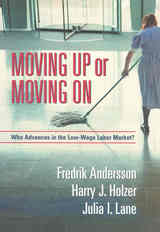
Moving Up or Moving On
Who Gets Ahead in the Low-Wage Labor Market?
Fredrik Andersson
Russell Sage Foundation, 2005
For over a decade, policy makers have emphasized work as the best means to escape poverty. However, millions of working Americans still fall below the poverty line. Though many of these "working poor" remain mired in poverty for long periods, some eventually climb their way up the earnings ladder. These success stories show that the low wage labor market is not necessarily a dead end, but little research to date has focused on how these upwardly mobile workers get ahead. In Moving Up or Moving On, Fredrik Andersson, Harry Holzer, and Julia Lane examine the characteristics of both employees and employers that lead to positive outcomes for workers. Using new Census data, Moving Up or Moving On follows a group of low earners over a nine-year period to analyze the behaviors and characteristics of individuals and employers that lead workers to successful career outcomes. The authors find that, in general, workers who "moved on" to different employers fared better than those who tried to "move up" within the same firm. While changing employers meant losing valuable job tenure and spending more time out of work than those who stayed put, workers who left their jobs in search of better opportunity elsewhere ended up with significantly higher earnings in the long term—in large part because they were able to find employers that paid better wages and offered more possibilities for promotion. Yet moving on to better jobs is difficult for many of the working poor because they lack access to good-paying firms. Andersson, Holzer, and Lane demonstrate that low-wage workers tend to live far from good paying employers, making an improved transportation infrastructure a vital component of any public policy to improve job prospects for the poor. Labor market intermediaries can also help improve access to good employers. The authors find that one such intermediary, temporary help agencies, improved long-term outcomes for low-wage earners by giving them exposure to better-paying firms and therefore the opportunity to obtain better jobs. Taken together, these findings suggest that public policy can best serve the working poor by expanding their access to good employers, assisting them with job training and placement, and helping them to prepare for careers that combine both mobility and job retention strategies. Moving Up or Moving On offers a compelling argument about how low-wage workers can achieve upward mobility, and how public policy can facilitate the process. Clearly written and based on an abundance of new data, this book provides concrete, practical answers to the large questions surrounding the low-wage labor market.
[more]
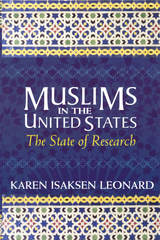
Muslims in the United States
The State of Research
Karen Isaksen Leonard
Russell Sage Foundation, 2003
As the United States wages war on terrorism, the country's attention is riveted on the Muslim world as never before. While many cursory press accounts dealing with Muslims in the United States have been published since 9/11, few people are aware of the wealth of scholarly research already available on the American Islamic population. In Muslims in the United States: The State of Research, Karen Isaksen Leonard mines this rich vein of research to provide a fascinating overview of the history and contemporary situation of American Muslim communities. Leonard describes how Islam, never a monolithic religion, has inevitably been shaped by its experience on American soil. American Muslims are a religious minority, and arbiters of Islamic cultural values and jurisprudence must operate within the framework of America's secular social and legal codes, while coping with the ethnic differences among Muslim groups that have long divided their communities. Arab Muslims tend to dominate mosque functions and teaching Arabic and the Qur'an, whereas South Asian Muslims have often focused on the regional and national mobilization of Muslims around religious and political issues. By the end of the 20th century, however, many Muslim immigrants had become American citizens, prompting greater interchange among these groups and bridging some cultural differences. African American Muslims remain the most isolated group—a minority within a minority. Many African American men have converted to Islam while in prison, leading to a special concern among African American Muslims for civil and religious rights within the prison system. Leonard highlights the need to expand our knowledge of African American Muslim movements, which are often not regarded as legitimate by immigrant Muslims. Leonard explores the construction of contemporary American Muslim identities, examining such factors as gender, sexuality, race, class, and generational differences within the many smaller national origin and sectarian Muslim communities, including secular Muslims, Sufis, and fundamentalists. Muslims in the United States provides a thorough account of the impact of September 11th on the Muslim community. Before the terrorist attacks, Muslim leaders had been mostly optimistic, envisioning a growing role for Muslims in U.S. society. Afterward, despite a brave show of unity and support for the nation, Muslim organizations became more open in showing their own conflicts and divisions and more vocal in opposing militant Islamic ideologies. By providing a concise summary of significant historical and contemporary research on Muslims in the United States, this volume will become an essential resource for both the scholar and the general reader interested in understanding the diverse communities that constitute Muslim America.
[more]
READERS
Browse our collection.
PUBLISHERS
See BiblioVault's publisher services.
STUDENT SERVICES
Files for college accessibility offices.
UChicago Accessibility Resources
home | accessibility | search | about | contact us
BiblioVault ® 2001 - 2024
The University of Chicago Press









